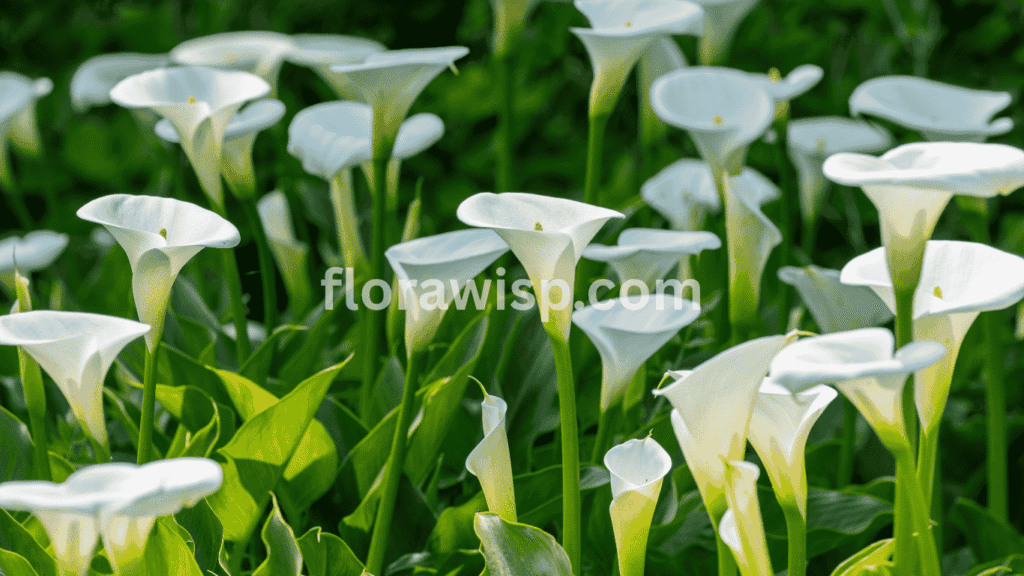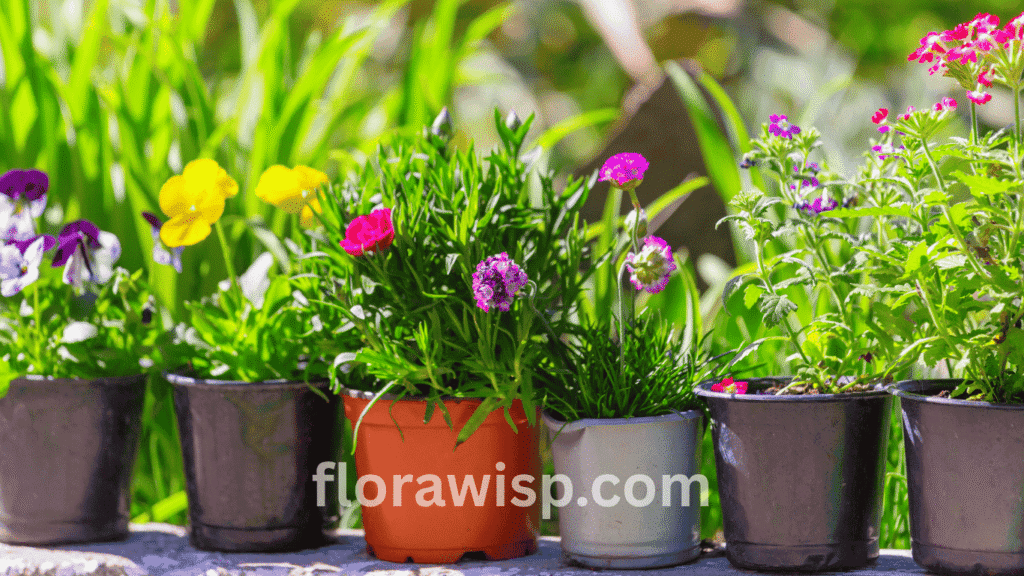Calla lily (Zantedeschia) is elegant, funnel-shaped blooms that thrive in warm U.S. zones (USDA 8–10) and are grown as summer bulbs in cooler areas. These plants love rich, moist, well-draining soil and partial sun making them perfect for containers, flower beds, or indoor displays. Whether you’re planting lily bulbs or buying potted ones, they need consistent moisture and monthly feeding during growth.
Their bloom season runs from late spring through midsummer, though with the right light, potted callas can rebloom indoors. Colors range from classic white (popular in weddings) to vibrant pink, purple, yellow, and even deep black each carrying a symbolic meaning tied to purity, passion, or rebirth.
In this guide, I’ll cover how to plant and care for calla lilies, when they bloom, what they symbolize, how they spread, and whether they’re safe around pets. Backed by firsthand experience and tested tips, this article gives you everything you need to grow calla lilies confidently, whether you’re a beginner or an enthusiast.
We,ll Explore
Calla Lilies Meaning, Symbolism & Cultural Significance
As a lifelong gardener with a deep love for elegant blooms, few flowers have struck me like the calla lily. Beyond its stunning appearance, this plant carries layers of meaning that resonate in gardens, homes, and ceremonies across the world.
A Flower with Deep Roots in Symbolism
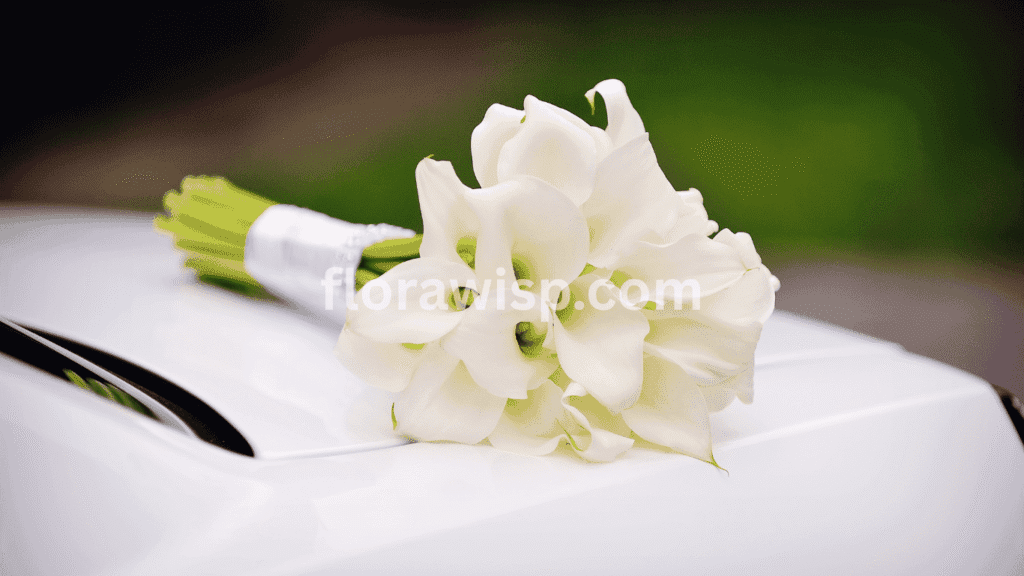
The calla lily meaning varies by color and occasion. White calla lilies, often seen in bridal bouquets and church altars, symbolize purity, innocence, and new beginnings. I’ve used them in countless wedding arrangements, and they never fail to add grace and serenity to the setting.
On the other hand, deep purple or black calla lilies represent elegance, mystery, and sometimes mourning. In memorial gardens I’ve designed, these darker varieties have offered a quiet beauty that speaks volumes. Their presence can bring comfort, especially when words fall short.
Cultural & Historical Significance of the Calla Lilies
The calla lily symbolism stretches back to ancient times. The word “calla” comes from the Greek kallos, meaning beauty. In Roman culture, the calla lily flower meaning was tied to celebration and fertility, making it popular in festivals. Today, they’re found in both joyous and somber moments weddings, baptisms, and funerals thanks to their striking form and emotional flexibility.
In my own experience, planting calla lilies in reflective garden corners has transformed those spaces into symbols of peace and remembrance. Whether you’re seeking to add spiritual depth, timeless elegance, or a touch of symbolism to your garden, the calla lily offers profound beauty and cultural richness that few flowers can match. For another flower with deep spiritual roots and fragrant charm, explore the grace of the Lily of the Valley, a timeless favorite among shade garden lovers.
Why Calla Lily Stands Out in Every Garden
The calla lily (Zantedeschia) is one of those plants that never fails to draw attention, yet remains surprisingly easy to care for. Despite its name, the calla lily isn’t a true lily; it belongs to the Araceae family. Native to southern Africa, it thrives in USDA Zones 8–10 but can be grown as an annual or lifted and stored in colder zones.
A Bloom Like No Other
What truly makes the calla lily flower unique is its elegant form. The bloom isn’t a flower in the typical sense; it’s a modified leaf called a spathe that wraps around a golden central spadix. This design gives the plant its sleek, trumpet-like appearance, making it a favorite for floral arrangements and modern garden designs alike.
I’ve grown calla lilies both in containers and directly in the ground near water features. They perform best in moist but well-drained soil, with morning sun and some afternoon shade, especially in warmer states like Georgia or Texas. When those blooms unfurl, whether in pure white or rich burgundy, they stop visitors in their tracks.
The Meaning Behind the Bloom
The calla lily meaning goes far beyond aesthetics. White lilies often symbolize purity and rebirth, making them popular in weddings and spiritual gardens. Meanwhile, darker shades like purple or black calla lilies carry connotations of elegance, mystery, and remembrance.
In my garden, I find that adding calla lilies flowers creates not just visual interest but emotional impact. Their presence is both grounding and uplifting a testament to why they’ve held deep significance in cultures around the world for centuries.
Calla Lily Care Guide for Healthy Blooms
Growing calla lilies has been one of the most rewarding experiences in my gardening journey. With the right attention to detail, these elegant blooms will thrive both outdoors and indoors. Whether you’re nurturing a calla lily in a pot or planting them in garden beds, consistent care is key. If you’re focusing on container gardening, don’t miss our detailed guide on Lilies in a Pot expert tips for planting, soil, and bloom care indoors.
Light & Placement: Indoor and Outdoor Tips

Outdoors, I plant them where they get dappled light. Too much direct sun can scorch the leaves, especially in hotter zones. For calla lily indoor plants, a south- or west-facing window with bright, indirect sunlight keeps them thriving. In my home, placing them near a humidifier made a noticeable difference.
Watering: Avoiding Yellow Leaves
A common issue many gardeners face is calla lily yellow leaves. This often points to overwatering or poor drainage. Early on, I learned the hard way that soggy roots lead to rot. Whether in beds or pots, always ensure your soil is moist but well-drained. For calla lily care indoors, I allow the top inch of soil to dry before watering again. Use containers with drainage holes to prevent excess moisture.
Feeding & Flowering Tips
Deadheading spent blooms not only keeps your plant tidy but encourages continuous flowering. For calla lily in pots, I apply a balanced liquid fertilizer monthly during the growing season. It’s made a huge difference in bloom quality.
Seasonal Dormancy: Letting Them Rest
When winter approaches, your calla lilies need a rest. I gradually reduce watering and trim back fading foliage. This natural dormancy strengthens the plant for the next blooming cycle.
By following these calla lily care tips, your garden or indoor space will be rewarded with stunning, long-lasting flowers. Trust me once you master their rhythm, calla lilies become one of the most low-maintenance yet spectacular additions to your plant collection.
Discovering the Beauty of Calla Lily Colors in Your Garden
Over my years as a gardener, few flowers have captured my admiration quite like the calla lily. These elegant, trumpet-shaped blooms add grace and color to any landscape. While the traditional white calla lily remains a classic symbol of purity and simplicity, modern hybrid varieties have unlocked a world of rich, vibrant colors that can transform your garden into a showpiece.
Let me walk you through the most stunning calla lily colors and types I’ve grown, along with how they perform in real-life gardens across the U.S.
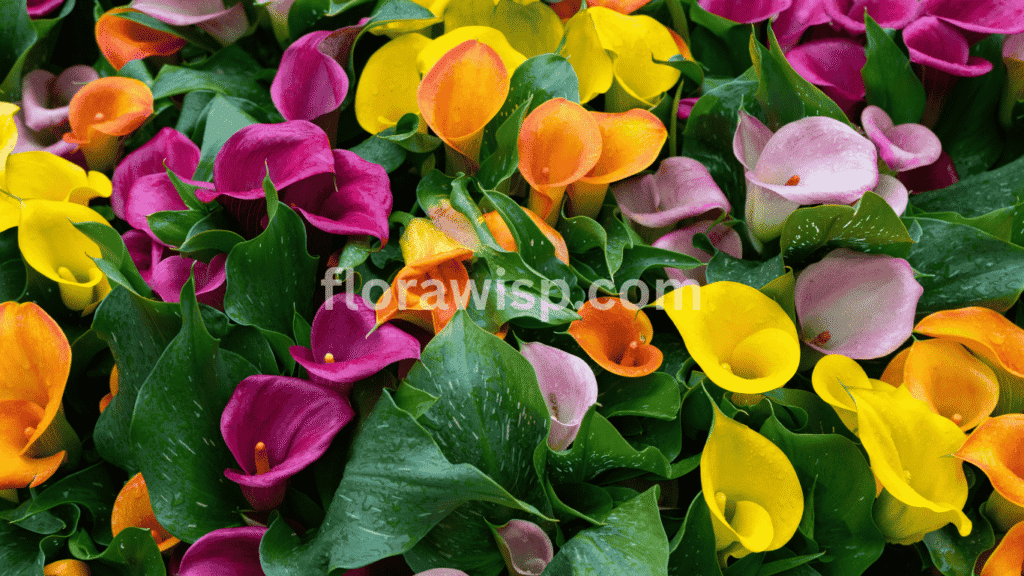
White Calla Lily: Timeless Elegance
The white calla lily is the original star. I’ve used it extensively in wedding-themed borders and memorial gardens. It pairs beautifully with dark mulch and provides a calming, clean presence ideal for peaceful corners. Its long stems and clean appearance also make it one of the best choices for cutting gardens.
Garden tip: Plant white callas near seating areas. They look striking at dusk and are deer-resistant too.
Black Calla Lily: Bold & Sophisticated
When I first introduced the black calla lily to a shaded garden bed, the contrast against lighter foliage was absolutely stunning. It’s not truly black, but such a deep purple it appears velvety in the sunlight. This dark calla lily brings a modern edge and pairs beautifully with white or soft pink blooms for an elegant contrast.
Purple Calla Lily & Dark Purple Varieties
The purple calla lily adds a regal, dramatic touch. In cooler zones, it tends to bloom more intensely. My dark purple cultivars are almost black draw compliments from visitors every summer. They’re a favorite in moon gardens and mixed borders.
Expert note: Combine purple and dark purple calla lilies with silvery foliage like dusty miller for a stunning nighttime effect.
Pink & Red Calla Lilies
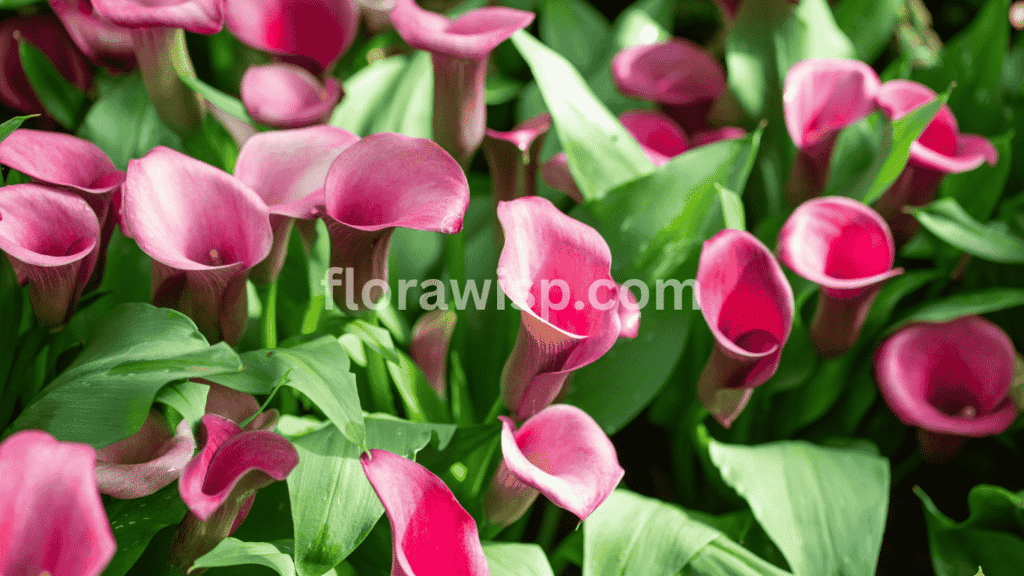
In containers and around patios, pink calla lilies and red calla lilies bring romantic energy. I find red varieties particularly captivating in sunlight; they almost glow! These colors are also pollinator-friendly, attracting bees and butterflies.
Orange & Yellow Calla Lilies
If you’re looking to brighten up your garden, orange calla lilies and yellow calla lilies are the way to go. I’ve planted them near my garden entrance to offer guests a warm, tropical welcome. They bloom well in full sun and thrive in Zones 8–10 with little fuss.
Quick tip: Add these cheerful varieties near evergreens for year-round contrast.
Blue Calla Lily: Rare & Enigmatic
Although not true blue, some hybrids have bluish-purple tones. These blue calla lilies are conversation starters. I grow them in terracotta pots to highlight their unique color against natural clay.
Mini Calla Lily: Compact and Charming
For small-space gardeners or container lovers, mini calla lilies are a blessing. I often tuck them into my raised beds or use them in seasonal floral arrangements. Despite their size, they offer the same flair.
Growing and Pairing Calla Lily Types
Each of these calla lily types brings something unique to your garden. I’ve found that combining several calla lily colors in a single bed creates visual depth and year-round interest. Whether you’re planting in containers, raised beds, or mass plantings, callas offer flexibility with undeniable charm.
From the peaceful elegance of the white calla lily to the striking presence of the black calla lily and the vibrant joy of orange calla lilies, there’s a variety for every mood and garden style. Choose the ones that resonate with your aesthetic, and let your garden bloom with personality.
How to Grow and Plant Calla Lilies from Bulbs or Seeds
Over the past few years growing calla lilies across USDA Zones 7 to 10, I’ve come to trust one method above all planting calla lily bulbs, also known as rhizomes. They’re reliable, fast to sprout, and bloom beautifully when cared for right. While calla lily seeds are available, they demand patience and controlled conditions that most home gardeners find tricky.
Start with the Right Bulbs or Rhizomes
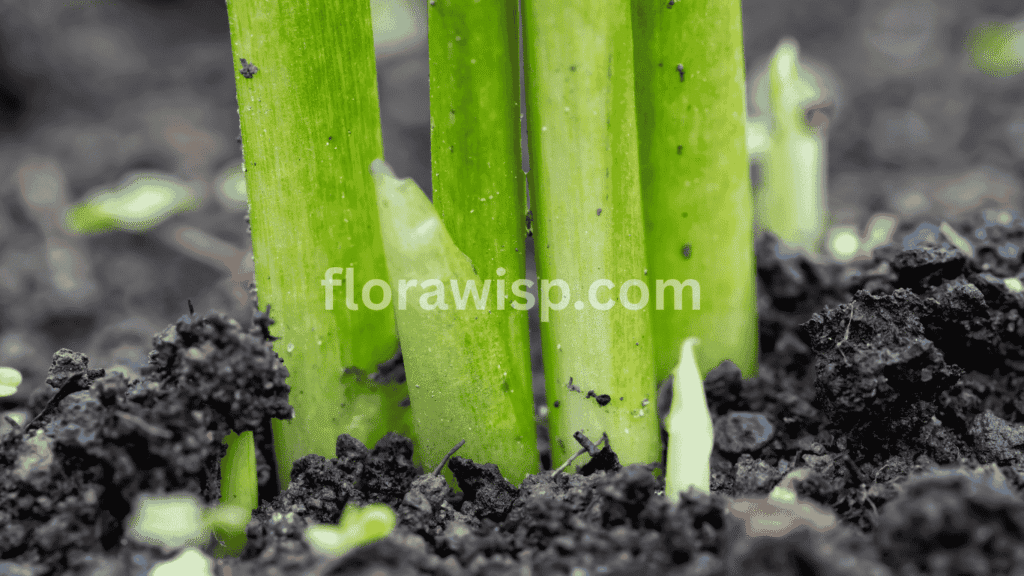
When selecting calla lily bulbs (technically rhizomes), ensure they’re firm and plump, not dried out or mushy. For beginners, I always suggest buying from trusted nurseries or ordering calla lily bulbs in bulk for larger beds. I once planted over 300 calla lilies bulbs for a neighborhood memorial garden and saw a stunning 90% bloom rate all from quality calla lily rhizomes sourced in California.
Planting Calla Lily Bulbs Step-by-Step
Here’s exactly how to plant calla lily bulbs for success:
- Timing: Wait until after the last spring frost. Soil temperatures should be above 60°F.
- Depth: Dig a hole about 3 inches deep and place the bulb with the “eye” facing up.
- Spacing: Keep 12-inch gaps between bulbs for airflow and growth.
- Soil: Use humus-rich, well-draining soil. Incorporate compost for nutrients.
- Zones: If you’re in Zones 3–7, plant in containers so you can overwinter them indoors. In warmer zones, a thick mulch layer will protect rhizomes year-round.
If you’re experimenting with calla lily plant seeds, sow them indoors 8 weeks before the last frost. Use a seed tray with consistent warmth and humidity. But from experience, germination is slow and less predictable compared to rhizomes.
Best Soil and Fertilizer Methods for Calla Lilies
The secret to vibrant calla lily blooms lies beneath the surface healthy soil and the right fertilizer makes all the difference.
Ideal Soil for Calla Lily

Soil for calla lily should be slightly acidic to neutral, with a pH between 6.0 and 7.0. I always mix compost, peat moss, and perlite into my garden beds for a loose, airy texture that supports rhizome growth. Whether you’re planting outdoors or caring for indoor calla lily containers, drainage is critical. Waterlogged roots will quickly rot your bulbs.
Calla Lily Fertilizer Routine
In my experience, the best calla lily fertilizer is a balanced 10-10-10 formula. I apply a slow-release version at planting and follow up monthly with a water-soluble blend during active growth.
- Early Growth (Spring): Apply fertilizer once shoots appear.
- Bloom Period (Summer): Feed monthly with diluted liquid fertilizer to fuel flowering.
- Dormancy (Fall–Winter): Stop fertilizing once foliage yellows and the plant enters dormancy.
Avoid high-nitrogen products that push leaf growth at the expense of flowers.
Indoor Calla Lily Care
Growing indoor calla lilies requires good light, warm temps, and occasional feeding. I use a tropical potting mix with added bark and perlite for container-grown lilies. Keep them in bright indirect light, avoid soggy soil, and reduce watering once dormancy kicks in.
Calla Lily Bouquets for Weddings and Events
As a longtime floral designer and gardener specializing in wedding florals, I can confidently say few flowers match the elegance of the calla lily bouquet. Its smooth, trumpet-shaped bloom and sophisticated posture make it a standout in bridal arrangements.
Why Brides Love the Calla Lily Bouquet
Over the years, I’ve crafted dozens of calla lily bouquet wedding sets, each reflecting a couple’s unique vision. For a timeless look, the white calla lily bouquet remains unmatched symbolizing purity and grace, especially in spring weddings. In contrast, the black calla lily bouquet brings a bold, gothic aesthetic that perfectly suits fall or evening ceremonies.

The calla lily bouquet bride choices often vary by season and theme, but the structure and symbolism of these blooms remain a constant favorite. For minimalist brides, a single calla lily bouquet wrapped in silk ribbon offers a modern, refined touch. Meanwhile, those opting for lush arrangements typically favor calla lily and rose bouquets for added volume and fragrance.
Mixing and Matching with Other Flowers
Calla lilies pair beautifully with everything from orchids and roses to unexpected textures like succulents. A calla lilies wedding bouquet mixed with blush roses and dusty miller brings a soft romantic tone, while burgundy orchids can elevate a white base with dramatic flair.
For grooms and groomsmen, the calla lily boutonniere remains a staple. I often recommend using a single black or white bloom with eucalyptus for a sleek, polished look.
Seasonal Inspirations
Spring calls for lighter palettes like white and blush calla lily wedding flower bouquets, while autumn invites deeper tones like plum or black paired with foliage. Seasonal availability and color trends matter, especially when planning a large event. Don’t forget to consult with your florist early if you want rare colors like mango, deep purple, or even two-toned blooms.
Whether you’re creating an understated bouquet of calla lilies or an elaborate, mixed-flower masterpiece, these blooms bring effortless beauty to any celebration.
Where to Buy Calla Lilies, Bulbs, and Seeds
Finding high-quality calla lily bulbs play a vital role in the garden’s success. After years of growing lilies across Zones 7 to 9, I’ve learned that sourcing from reputable suppliers is non-negotiable.
Local vs. Online: What Works Best?
While many gardeners rely on buying calla lily plants at local nurseries, especially in early spring I often turn to online specialists when seeking rare colors like black calla lilies or the elusive blue shades.
Online nurseries in Oregon and California are my top picks for bulk purchases. Their climate favors calla cultivation, and they often ship certified disease-free bulbs with clear planting instructions.
If you see listings that vaguely say “calla lilies for sale” without botanical names or zone info, steer clear. I’ve seen too many gardeners receive mislabeled bulbs that bloom as entirely different species or worse, never sprout.
Tips Before You Buy Calla Lily Bulbs or Plants
- Check certification: Always opt for sellers offering certified virus- and rot-free calla lily bulbs.
- Ask about variety names: Whether you want Picasso, Crystal Blush, or Odessa, names matter.
- Plan for delivery: For those shopping online, choose calla lily delivery options with guaranteed shipping timelines. Early spring is ideal for planting in USDA Zones 7–9.
You can also search “calla lilies near me” to explore local suppliers, especially around bloom season, but always confirm the color and variety before purchase. For larger landscaping projects, purchasing bulk calla lily directly from growers often yields healthier, more robust plants.
FAQs
Q. How do I care for calla lilies?
To keep calla lilies thriving, ensure moist but well-drained soil and indirect sunlight. I water mine when the top inch dries and fertilize monthly during the growing season. Indoors, misting or using a humidifier helps maintain humidity, especially in dry zones. Whether potted or in-ground, they respond well to consistent care and reward you with longer blooming cycles and vibrant leaves.
Q. How to plant calla lily bulbs?
Plant calla lily bulbs 3 inches deep with the growing tips (eyes) facing up in loose, well-draining soil. I’ve found partial sun works best with full morning sun with afternoon shade. In USDA Zones 7 and below, I start mine indoors 6 weeks before the last frost. Mulch helps retain moisture and protect the rhizomes if planted outside. Container planting gives added flexibility for colder regions.
Q. When do calla lilies bloom?
Calla lilies bloom from late spring through mid-summer, usually May to July in most U.S. zones. My garden-grown callas begin flowering in early May, especially when temperatures stay between 60–75°F. Indoors, with stable lighting and temperature, they’ve bloomed twice a year once in spring, then again in early fall. Good soil and feeding directly impact their flowering cycle.
Q. Do calla lilies spread?
Yes, calla lilies naturally spread through underground rhizomes. I’ve watched a single bulb in my border expand into a lush 3-foot clump in just two growing seasons. If left undivided, they can overcrowd the bed and reduce flowering. Every 2–3 years, I divide and replant to rejuvenate growth and maintain shape. This is also a great way to multiply your stock.
Q. How long do potted calla lilies last?
Potted calla lilies bloom for 6–8 weeks under ideal care, especially with consistent moisture and bright, indirect light. After blooming, they enter dormancy. I move mine to a cool, dark corner and stop watering until new shoots appear. With this rest cycle, they bounce back beautifully each year. Repotting and dividing during dormancy also improves next season’s blooms.
Conclusion
Calla lilies are more than just beautiful blooms; they carry rich symbolism, cultural depth, and elegant simplicity. From my years of gardening experience, I’ve seen how their symbolism from purity to remembrance makes them meaningful additions to any garden or floral arrangement.
Whether you’re planting calla lily bulbs for their elegant summer flowers or exploring their meaning for a special occasion, this plant rewards care with striking grace. By understanding calla lily symbolism, bloom habits, and care needs, you can grow them confidently and even multiply them over time. If you’re drawn to symbolic houseplants, don’t miss our guide on the Peace Lily Flower, another elegant plant known for its meaning and low-maintenance charm. With the right touch, calla lilies will grace your space year after year. With the right touch, calla lilies will grace your space year after year.
References
The Spruce: How often to water Calla Lilies
NC State University Extension – “Zantedeschia aethiopica” Plant Profile
Harvest to Table – “How to Grow Calla Lily — Zantedeschia”
Gardener, M.Sc. Horticulture
Elara Bennet is a gardening writer from Austin, TX, passionate about sustainable lawns and blooms. Read full bio →

